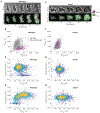Heterogeneity in efflux pump expression predisposes antibiotic-resistant cells to mutation
- PMID: 30409883
- PMCID: PMC6343669
- DOI: 10.1126/science.aar7981
Heterogeneity in efflux pump expression predisposes antibiotic-resistant cells to mutation
Abstract
Antibiotic resistance is often the result of mutations that block drug activity; however, bacteria also evade antibiotics by transiently expressing genes such as multidrug efflux pumps. A crucial question is whether transient resistance can promote permanent genetic changes. Previous studies have established that antibiotic treatment can select tolerant cells that then mutate to achieve permanent resistance. Whether these mutations result from antibiotic stress or preexist within the population is unclear. To address this question, we focused on the multidrug pump AcrAB-TolC. Using time-lapse microscopy, we found that cells with higher acrAB expression have lower expression of the DNA mismatch repair gene mutS, lower growth rates, and higher mutation frequencies. Thus, transient antibiotic resistance from elevated acrAB expression can promote spontaneous mutations within single cells.
Copyright © 2018 The Authors, some rights reserved; exclusive licensee American Association for the Advancement of Science. No claim to original U.S. Government Works.
Conflict of interest statement
Figures



Comment in
-
Reduce your speed.Nat Rev Microbiol. 2019 Jan;17(1):1. doi: 10.1038/s41579-018-0127-8. Nat Rev Microbiol. 2019. PMID: 30470813 No abstract available.
References
Publication types
MeSH terms
Substances
Grants and funding
LinkOut - more resources
Full Text Sources
Other Literature Sources
Medical
Molecular Biology Databases
Research Materials

